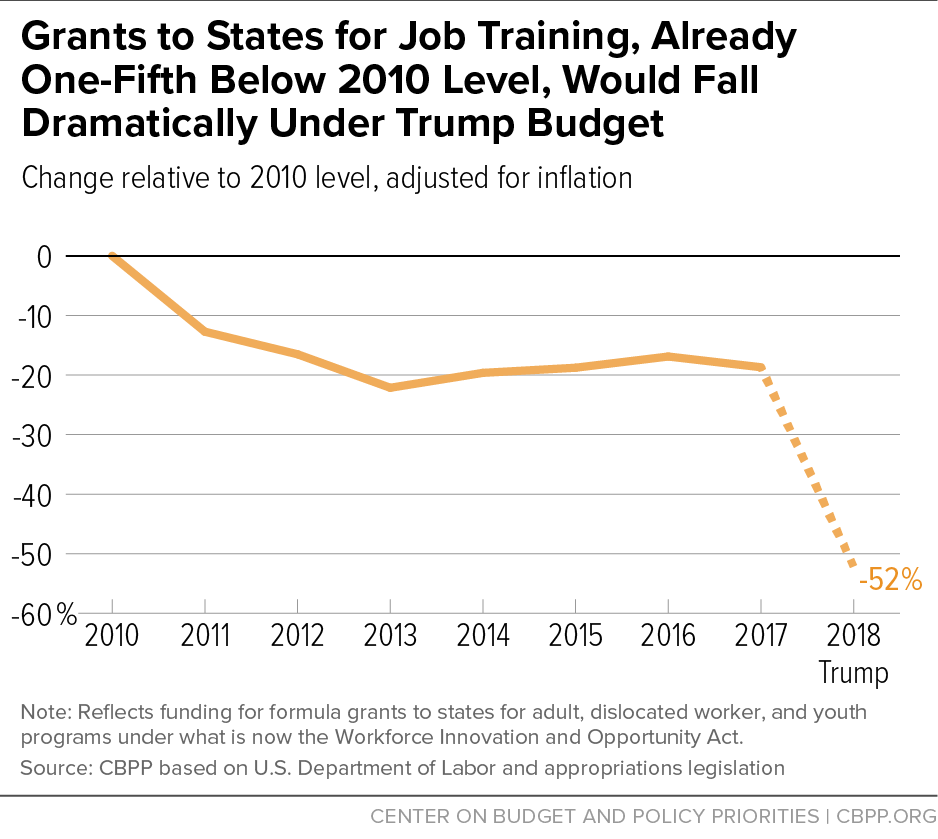BEYOND THE NUMBERS
Contrary to President’s Rhetoric This Week, His Budget Undercuts Workforce Development
President Trump is expected to argue this week that he prioritizes workforce development but, as we’ve detailed here and here, his budget consistently and substantially cuts a range of training and education programs aimed at preparing people for, and helping people secure, good jobs. The Trump budget would:
- Cut core job training grants to states and communities by two-fifths, and nationally administered grants by one-third, in 2018 alone. The Labor Department’s Workforce Innovation and Opportunity Act (WIOA) provides grants to states and communities for job training for adults, dislocated workers, and young people (with an emphasis on youth who are neither in school nor working). The budget would cut these grants by 40 percent next year (from $2.7 billion in 2017 to $1.6 billion in 2018), even though they’ve already been cut significantly since 2010. Thus, under Trump, funding for these job training grants in 2018 would be less than half its 2010 level (see chart), after adjusting for inflation.
The budget would also cut other Labor Department job training grants, including a 47 percent cut to the national fund that assists workers dislocated by large events such as natural disasters and mass layoffs, and the elimination of job training grants for migrant and seasonal farmworkers.
These cuts would very likely grow considerably after 2018, as the budget proposes much deeper cuts to non-defense discretionary (NDD) spending — the budget category that covers job training, as well as a broad set of public services, investments in our economy, and initiatives that promote opportunity — over the next decade.
President Trump proposes these cuts despite bipartisan 2014 legislation to strengthen these job training programs, and despite widespread recognition that today’s jobs require workers with more skills.
- Cut programs that help all Americans get the basic education they need to make them employable. The budget would cut the Education Department’s elementary and secondary school programs by $4 billion (9 percent) in 2018, eliminating various grants that include aid to after-school programs in high-need schools. It would also cut Education Department programs providing vocational training and basic skills needed for employment: career and technical education by 13 percent and adult education by 16 percent.
- Make college less affordable for many low-income students, making it harder for them to get the education needed to secure decent-paying jobs. The budget would significantly cut student aid, including eliminating a campus-based grant program for low-income students and cutting work-study opportunities in half. It also fails to extend a provision adjusting Pell Grants for inflation, so these grants would cover an ever-shrinking share of college costs over time. Even today, Pell Grants cover less than 30 percent of the cost of attending a public four-year college, on average — the lowest point in the program’s 40-plus-year history. The budget cuts student loans by more than $140 billion over the next decade but reinvests none of those savings to protect the Pell Grant from inflation or to otherwise make college more affordable.
To demonstrate his interest in workforce development, President Trump will reportedly tout apprenticeship programs and emphasize that his budget would reorganize existing workforce development programs to make them more efficient. Apprenticeship programs are important and should be expanded, but they’re just one part of a workforce development strategy. Moreover, the budget devotes only $90 million to apprenticeship programs, the same as in 2016 and 2017 and less than 5 percent of the Labor Department’s training and employment services budget. And “reorganization” and “efficiency” are terms that policymakers often use to put a positive spin on their proposed program cuts, and the President’s proposal to sharply cut the nation’s primary job training programs (which, as noted, have been recently refreshed in a bipartisan effort) by two-fifths is further evidence that we should ignore such spin.

